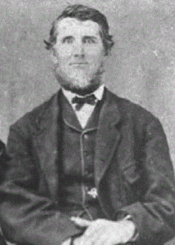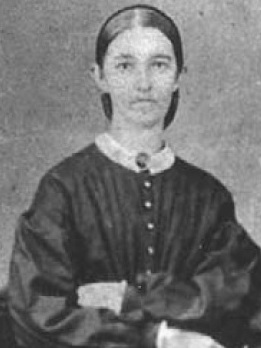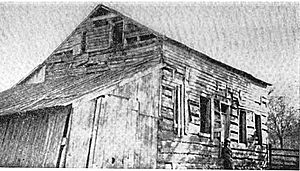Lyman Wight facts for kids
Quick facts for kids Lyman Wight |
|
|---|---|
 |
|
| President of the Church of Christ | |
| 1844 – 1858 | |
| Predecessor | Joseph Smith |
| Successor | None |
| Reason | Succession crisis |
| Quorum of the Twelve Apostles | |
| April 8, 1841 – December 3, 1848 | |
| End reason | Excommunicated for apostasy |
| Latter Day Saint Apostle | |
| April 8, 1841 – December 3, 1848 | |
| Reason | Replenishing Quorum of the Twelve |
| End reason | Excommunicated for apostasy |
| Reorganization at end of term |
Charles C. Rich, Lorenzo Snow, Erastus Snow, and Franklin D. Richards ordained |
| Personal details | |
| Born | May 9, 1796 Fairfield, New York, United States |
| Died | March 31, 1858 (aged 61) Mountain Valley, Texas, United States |
Lyman Wight (born May 9, 1796 – died March 31, 1858) was an important early leader in the Latter Day Saint movement. He led the Latter Day Saints in Daviess County, Missouri, in 1838. In 1841, he became a member of the Quorum of the Twelve Apostles.
After the death of Joseph Smith, there was a disagreement about who should lead the church next. This is called a succession crisis. Lyman Wight decided to lead his own group of Latter Day Saints to Texas. There, they started a new settlement. While in Texas, Wight chose not to follow the main group led by Brigham Young. Wight became the president of his own church. Later, he supported the claims of William Smith and then Joseph Smith III. After Wight's death, most of his followers, known as "Wightites," joined the Reorganized Church of Jesus Christ of Latter Day Saints (RLDS Church).
Contents
Early Life and Family
Lyman Wight was born in Fairfield, New York, on May 9, 1796. His parents were Levi Wight and Sarah Corton. He served as a soldier in the War of 1812.
On January 5, 1823, he married Harriet Benton in Henrietta, New York. Around 1826, Wight moved to Warrensville Township, Ohio. In May 1829, he was baptized into the Reformed Baptist faith by Sidney Rigdon. In February 1830, Wight joined Isaac Morley and others to form a community in Kirtland, Ohio. Lyman Wight eventually had four wives and eleven children.
Service in the Church
Lyman Wight was baptized into the Church of Christ by Oliver Cowdery on November 14, 1830. In June 1831, he became a high priest. He was asked to travel from Kirtland to Missouri, preaching along the way. He said he had seen Jesus Christ.
Soon after, Wight went to Missouri and then Cincinnati, Ohio, to preach. He baptized more than 100 people there. Wight served eleven missions during his time in the church.
Challenges in Missouri
Wight and many of his new church members moved to Independence, Missouri. They wanted to build the "City of Zion" there. The Mormons in Jackson County faced difficulties with their neighbors.
In July 1833, Wight signed an agreement for the Latter Day Saints to leave Jackson County by 1834. However, the Saints were forced to leave earlier and moved to nearby Clay County. Church members asked elders to tell Joseph Smith about these events. When others hesitated, Wight volunteered to make the journey, even though his wife was ill with a newborn child. Parley P. Pratt joined him.
Wight and Pratt reached Kirtland, Ohio, on February 22, 1834. They shared their experiences with the church leaders. This led to the creation of Zion's Camp. Joseph Smith sent people to find volunteers. Wight left on April 21 with Hyrum Smith to recruit people from the northwestern United States. It was hard to find volunteers because many did not want to leave their homes. Smith and Wight recruited about twenty people, including Hosea Stout. They met the main group on June 8 in Missouri. The camp had 207 men, 11 women, 11 children, and 25 wagons.
Wight accepted the difficult conditions of the camp, trusting Joseph Smith's promises. After a long 900-mile march, many members of the camp became sick with cholera. The camp was then ended without achieving its goal of returning the Latter Day Saints to Jackson County. Wight wrote the orders for the camp to disband and stayed in Missouri as Smith had asked.
Preaching Journeys
For the rest of 1834, Wight worked making bricks in Missouri. He built a large brick house for Colonel Arthur of Clay County. He hired several people, including Wilford Woodruff, to help him.
In 1835, Wight was encouraged to travel to the temple in Kirtland. He preached during his journey. He stopped in Richmond, Indiana. He knew that some people there did not like Mormons. Still, he arranged to preach at the courthouse. When he arrived, people were there with tar and feathers, planning to harm him. He preached for about two hours, speaking strongly about their actions. At the end, he asked if any gentleman would invite him to stay. A man stepped forward and invited him. His host was surprised by how well Wight seemed to know the people. Wight was treated kindly and given money for his journey.
Leading in Daviess County
Wight spent the winter in Kirtland and returned to Missouri in 1836. In 1837, he was accused of teaching wrong ideas by apostle David W. Patten. He was tried and found guilty. Wight then apologized and made things right.
Around February 1, 1838, Wight settled near the Grand River in Daviess County, Missouri. He built a house and a ferry, which became known as "Wight's Ferry." On May 19, 1838, Joseph Smith visited Wight's home and ferry. From Wight's house, Smith received a revelation about Adam-ondi-Ahman. This revelation spoke of a future gathering there.
On June 28, 1838, Joseph Smith organized a church stake at Adam-ondi-Ahman. His uncle John Smith was president, with Reynolds Cahoon and Wight as counselors. After this, many church members moved to the area, including new members and those seeking safety from Kirtland.
Wight also became a Colonel in the state militia. He was also a leader of the Danite organization in Daviess County. Because of his many roles, Wight became a very important leader for the Latter Day Saints in the county.
Times of Conflict in Missouri
In the summer of 1838, difficult times began in Missouri. This period is sometimes called the Mormon War. Wight helped organize people to protect the Latter Day Saints in Daviess County. Wight and Joseph Smith were accused of organizing a group and causing trouble for some older settlers. Smith and Wight agreed to be tried in court to help calm things down. On September 7, 1838, they appeared before Judge Austin A. King. They were ordered to stand trial later.
After the trial, tensions remained high. Latter Day Saints and non-Mormons in Daviess County had small conflicts. People from other counties came to Daviess County and caused problems for the Latter Day Saints. They damaged homes and took property. Many people sought safety in Adam-ondi-Ahman. In response, the Mormons gathered volunteers from Caldwell County. They joined with the Daviess men and divided into groups. Wight led one group. Many old settlers and their families left the area.
After these events, the Battle of Crooked River took place. Smith advised every church member to go to Adam-ondi-Ahman or Far West for protection. When Far West was surrounded after a state order, Wight organized members in Adam-ondi-Ahman to help. However, no major battle happened. Wight and other Mormon leaders were arrested by the state militia.
While in custody, Wight faced harsh treatment. A military trial that could have led to his execution was stopped by General Alexander William Doniphan. Instead, Wight and the other leaders were tried in civil courts. Wight and other leaders were able to escape from jail on April 6, 1839, while being moved to Boone County.
Nauvoo Era
Joseph Smith ordained Wight as an apostle of the church on April 8, 1841. He replaced Patten, who had died in 1838. Wight and George Miller were put in charge of a church company that ran mills and logged timber in Wisconsin. Much of the wood for the Nauvoo Temple and the Nauvoo House was floated down the Mississippi River from these Mormon mills.
After Joseph Smith's Death
Starting a New Path
After Joseph Smith's death, there was a disagreement about who should lead the church. Lyman Wight felt he needed to follow earlier instructions from Smith. These instructions were to create a safe place for Latter Day Saints in the Republic of Texas.
Brigham Young tried several times to convince Wight to join the main group of Latter-day Saints. Young had organized this group as The Church of Jesus Christ of Latter-day Saints in the area that would become Utah Territory. However, Wight refused each time. He did not accept Young as the new prophet. Wight was eventually removed from the church by Young on December 3, 1848. His important follower, Bishop George Miller, was also removed.
Settling in Texas
Wight moved his group of Latter Day Saints to the Republic of Texas. He started several communities there. Wight's followers built the first Latter Day Saint temple west of the Mississippi River. This temple was in Zodiac, Texas, near Fredericksburg. Important church ceremonies were performed in this temple by Wight's followers.
Today, the only remaining physical sign of the colony is the Mormon Mill cemetery. It is located near Hamilton Creek, about fifty miles east of Fredericksburg.
Leading His Own Church
Lyman Wight later recognized William Smith as the leader of the Latter Day Saints for a short time. Wight served as a helper in Smith's short-lived leadership group. After 1849, Wight wrote that he believed Joseph Smith's sons should lead the church. By then, Wight had decided that Brigham Young, William Smith, and James Strang were not the right successors to Smith. In 1851, the Pedernales River flooded and destroyed Zodiac. The Wightite colonists then moved to Burnet County, where they established Mormon Mill.
Death
Lyman Wight died on March 31, 1858, in Mountain Valley, Texas. He was 61 years old. He had been having epileptic spasms. Wight was living in Texas with a small group of his followers. His group had been traveling to Jackson County, Missouri. He wanted to rejoin other Latter Day Saints there. He was buried in his temple robes at the Mormon cemetery in Zodiac, which no longer exists. After Wight's death, most of his followers joined the RLDS Church. This church was renamed the Community of Christ in 2001 and was led by Joseph Smith III.
External resources
| Religious titles | ||
|---|---|---|
| Preceded by Willard Richards |
Quorum of the Twelve Apostles April 8, 1841 – 3 December 1848 |
Succeeded by Amasa M. Lyman |



